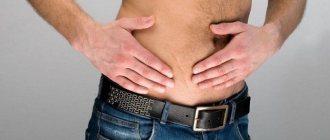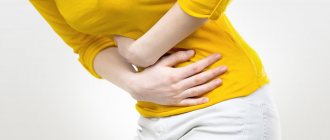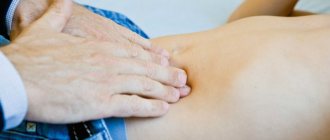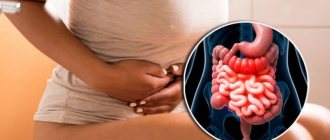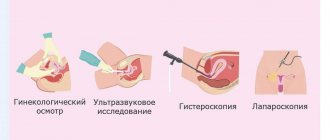Causes of pain
On the left side of the abdomen there are a large number of organs, each of which can cause pain. There are several possible causes for the condition:
- inflammation;
- injury;
- circulatory disorders (ischemia, heart attack);
- torsion of the ligaments of an internal organ;
- suppuration;
- systemic damage;
- genetic disease;
- poisoning;
- organ dysfunction;
- spasm;
- the appearance of a neoplasm.
A doctor should find out the cause during a face-to-face appointment. He will prescribe the necessary diagnostic procedures and select the optimal treatment.
Visceral pain
The cause of visceral pain can be functional disorders and organic changes in the organ. With functional disorders, this type of pain appears due to a decrease in the pain threshold and can affect all parts of the gastrointestinal tract2. In diseases of the digestive tract, visceral pain can be triggered by stretching, lack of blood supply, or peristalsis. Usually the patient feels it in the midline of the abdomen and is not able to accurately indicate the painful point2.
- The nature of visceral pain is cramping, with periods of subsiding and increasing pain. More often it can be described as aching, much less often - stitching or burning.
- Pain in diseases of the gastrointestinal tract can be caused by errors in diet, alcohol intake and exposure to factors such as running, bumpy riding, etc.
- The severity of pain can be reduced by warming or taking antispasmodics3.
Diagnostics
A doctor can guess the cause of pain through examination and palpation. The further diagnostic method is selected based on the results:
- general blood test - will indicate an infectious lesion, detect leukemia;
- general urinalysis - will help determine kidney pathology;
- Ultrasound is the fastest and easiest method for examining the abdominal organs;
- MRI - gives the most reliable results;
- colonoscopy - assessment of intestinal condition;
- radionuclide testing is relevant for some diseases of internal organs, for which other methods are not informative.
Based on the results of diagnostic measures, the patient is diagnosed. Pain treatment is selected according to the detected disease.
Read also: Pulling in the lower abdomen
Parietal pain
Another type of pain is parietal. It differs from the visceral one: it has a distinct localization in the area of the pathological process. Severe, painful and aggravated by sudden movements and coughing. It occurs due to irritation of the nerve receptors of the peritoneum, which covers the surface of the internal organs. It is projected onto the corresponding skin segments and is accompanied by tension in the muscles of the anterior abdominal wall2, 3.
Such pain, acutely occurring and intensifying, may be a sign of a serious pathology, so you should immediately consult a doctor3.
Possible diagnoses
Pain in the left side of the lower abdomen can be caused by damage to any organ located on this side. Possible diagnoses for such a patient:
- pathology of the spleen (abscess, heart attack, rupture, inflammation);
- lymphocytic leukemia or myeloid leukemia;
- intestinal pathology (malsorption, Crohn's disease, irritable bowel syndrome, ulcerative colitis, polyps, obstruction);
- oncology;
- pathologies of the reproductive organs (salpingitis, endometriosis, torsion of the ovarian pedicle, salpingoophoritis, adnexitis, rupture of uterine ligaments);
- ectopic pregnancy;
- kidney damage (enlargement of the pelvis).
Pain in the left side can be caused by other diagnoses, but radiate (transition) to this area. Therefore, it is important to contact a medical facility in a timely manner and conduct a comprehensive examination.
Causes of pain in the lower abdomen
The main causes of pain in the lower abdomen are as follows:
- Menstruation. Pain during menstruation is called dysmenorrhea. Dysmenorrhea can be primary (passes with the end of menstruation) and secondary (occurs against the background of an inflammatory process).
- Gynecological inflammatory diseases (adnexitis, endometritis, salpingitis, etc.). Most often accompanied by severe, aching pain that regularly bothers you. Other symptoms also appear, such as heavy discharge, a constant urge to urinate, a burning sensation and itching.
- Malignant formations;
- The presence of an ovarian cyst and symptomatic uterine fibroids;
- Endometriosis (a disease that damages the internal tissue of the uterus - the endometrium);
- Abortion;
- Consequences of inserting an intrauterine device.
Treatment
Treatment for a condition where the left side of the lower abdomen hurts depends on the diagnosis. Several groups of drugs can be used:
- painkillers - to relieve symptoms;
- antibiotics - for inflammation and suppuration;
- enzymes - for gastrointestinal pathologies;
- hormones - for endometriosis;
- sedatives - for irritable bowel syndrome;
- carminatives - for flatulence;
- chemotherapy - for oncology and leukemia.
If the pain is caused by kidney damage, special preparations and herbal teas may be prescribed. And in case of ectopic pregnancy, injuries and ruptures of organs, as well as in the absence of the ability to cure the patient with conservative methods, surgical intervention is performed.
Pain in the left side is a reason to consult a doctor in any case. But if they are of high intensity or began after a possible injury, this must be done urgently. Delay can threaten the patient with serious complications, including death.
Read also: Pulling in the lower abdomen during pregnancy
Dear patients! Remember that only a qualified doctor can make an accurate diagnosis, determine the causes and nature of the disease, and prescribe effective treatment. You can make an appointment with our specialists or call a doctor at home by calling 8-(4822)-33-00-33
Be healthy and happy!
What organs are located in the lower left corner of the abdomen?
Organs of different systems are located on the left lower abdomen. Digestion includes: the small intestine - loops of the jejunum, part of the descending colon and the sigmoid - large intestine. To the organs of the genitourinary system: the left half of the uterus, the left appendage with the ovary and fallopian tube in women, the ureter and part of the bladder.
We must not forget that pain on the left side of the lower abdomen can cause disturbances in the bone skeleton of the pelvis, hip joint, lymph nodes, nerve bundles and vessels, irradiation downward in diseases of the spleen and left kidney.
Prevention measures
The best preventive measure is timely contact with a specialist. It is much easier to treat the disease at an early stage. This will minimize the likelihood of complications. To prevent the re-development of intestinal diseases, you will need to follow a diet.
Usually it is enough to adhere to proper nutrition standards. Prevention of cystitis and diseases of the urinary system usually consists of maintaining good hygiene. Additionally, it is recommended to visit a gynecologist at least once every six months. Most gynecological diseases at an early stage are asymptomatic. Noticing them on your own is quite problematic.
Pregnancy should be completely under the supervision of a doctor. You need to register in a timely manner. A woman must undergo all preventive examinations. You should not refuse hospitalization, even if the doctor recommends it for preventive purposes or in case of a minor threat. In any case, it is better not to relieve pain, but to prevent it. To do this, you need to follow simple rules of hygiene, strengthen your immune system, engage in moderate physical activity, especially during sedentary work, adhere to a healthy lifestyle and monitor your diet.
What types of left side pain should you consider?
The nature of the pain serves as a guide to the assumption of the location and type of pathology.
Aching dull pain
Often worries women with a unilateral gynecological problem. Dull pain above the pubis and on the left is possible with cycle disorders, sex, inflammation and endometriosis. Inflammation is indicated by a combination with elevated temperature and weakness.
Nagging pain
In intensity it is significantly inferior to other types, but it exhausts a person with its constancy. In men, it occurs with inflammation of the scrotum, strangulated inguinal hernia, orchitis. Initially, a malignant tumor manifests itself in a similar way.
Sharp pain in the side
The sharp nature of the pain accompanies intestinal spasm, distension with gases, acute expansion of the bladder and pelvis of the left kidney during urinary retention, rupture of the ovary in women, and the passage of stones through the ureter.
Stitching pain
Colic is an acute spasm caused by contraction of the intestines or ureter. Typically subsides after defecation and urination. A type of pain is shooting pain. It is characteristic of inflammation in the lumbar region and joints. Stitching pain can precede the rupture of an ovarian cyst.
Pain in the lower left abdomen during pregnancy
If pregnant women have aching or pain in the left lower abdomen, the reasons may be different. A physiological factor in the development of pain may be the attachment of the fertilized egg to the left wall of the uterus, which is felt by the woman as a slight aching pain.
Attachment of the fertilized egg may be accompanied by mild aching pain
Pathological causes of pain include:
- state of uterine hypertonicity;
- the beginning of a miscarriage;
- development of isthmic-cervical insufficiency;
- Braxton-Higgs contractions;
- digestive disorders.
In any case, it is recommended that a pregnant woman consult a gynecologist.
Gynecological diseases in women
Pain in the lower left is a sign of a possible gynecological problem. There are a number of pathologies that manifest themselves with just such symptoms.
Inflammation of the appendages and uterus
Occurs due to infection. This often happens through the reproductive system (during sexual intercourse without proper protection). Freezing and hypothermia also occur. Patients complain of pain in the lower abdomen, which tends to become pronounced during sexual intercourse and urination. In this case, the stomach looks like a drum, and the temperature reaches 38C. In addition to the entire clinical picture, pus is released from the vagina, and sometimes bleeding. It is necessary to conduct an MRI and ultrasound. This disease is treated simply: analgesics, electrophoresis, Declofenac, antibiotics, and in advanced cases, the affected tissue is removed.
Ectopic pregnancy
A severe gynecological pathology that develops when a fertilized egg enters the uterine cavity (into the fallopian tube, ovary, abdominal cavity). Such a diagnosis can be suspected if the patient indicates frequent pain in the lower abdomen, localized in the groin and having the nature of attacks. The same pathology may be indicated by acute pain that occurs when a pipe ruptures. The pain tends to spread to the vagina, rectum and area above the collarbone.
In this case, there is a delay in menstruation and a positive pregnancy test. Bloody discharge may occur during an attack. Ectopic pregnancy leads to intracavitary bleeding and is an indication for emergency surgery. Women who have already had similar complications, have diseases of the genital organs and intrauterine devices are at risk for this disease.
Cystosis
The formation of cysts on the organs of the reproductive system is also a common disease that causes a pain symptom, which, as a rule, is mildly aching in nature. Often the cause of their formation is a hormonal imbalance, which becomes more frequent:
- during pregnancy;
- during menopause;
- in adolescence.
The pathology is dangerous because it develops without symptoms for a long time, and the woman does not even suspect that a cyst formation has begun inside the organ.
If the cyst is not detected in time or is not treated, complications may develop such as:
- cyst rupture;
- intra-abdominal bleeding;
- torsion of the cyst pedicle;
- peritonitis;
- degeneration of a cyst into a cancerous tumor.
The main symptoms of the late stage of cyst development:
- Discomfort and nagging pain in the lower abdomen.
- Disorders of the gastrointestinal tract.
- Bloating.
- Hair coarsening.
- Increased frequency of urination, pain, pain during urination.
Polycystic ovary syndrome
An increase in the size of the ovary due to multiple cystic formations often occurs due to malfunctions of the endocrine system, hormonal disorders, and neurological diseases.
The disease may not manifest itself for a long time and develop into dangerous diseases such as infertility, type 2 diabetes, vascular atherosclerosis and uterine cancer.
Therefore, it is important to identify pathology in time. Preferably at an early stage of development, for this you need to come to see a doctor, even if nothing is bothering you yet.
Endometrial polyp
This is a benign formation on the inner lining of the uterus. Polyps arise due to malfunctions of the endocrine and immune systems, hormonal disorders, metabolism in the body, etc.
Women usually become aware of the disease at a later stage of development, when pain symptoms occur, particularly in the left side of the lower abdomen. This symptom may be accompanied by:
- spotting brown discharge;
- irregularities in the menstrual cycle;
- intoxication: nausea, fever, weakness, etc.
Externally, this disease is very similar to a malignant tumor. And only timely diagnosis will help establish the type and nature of the neoplasm in a woman’s body.
Cervical erosion
An erosion or ulcer in the vaginal part of the cervix also causes pain in the lower abdomen on the left.
The causes of the pathology can be operations and abortions, early and promiscuous sex life, reduced immunity, addictions, and so on.
Sometimes it develops without symptoms, and the ulcer grows quickly and can develop into a malignant tumor. An examination by a gynecologist is the only way to detect and treat cervical erosion.
The disease manifests itself with mucous or bloody discharge.
Premenstrual syndrome
Every woman knows the state of increased nervousness and nagging pain in the lower abdomen a few days before the onset of menstruation. This symptom can be simply unbearable if women have suffered:
- operations and abortions;
- difficult childbirth;
- infectious diseases;
- frequent stress, overwork.
At this time, the stomach may hurt in any part of it, the lower back, or the back. Swelling and dizziness, increased irritability and depression, frequent or difficult urination, constipation or diarrhea, etc. appear.
Other causes of pain
A relatively rare disease is Hirschsprung's disease, which is transmitted hereditarily mainly to boys.
Abdominal pain and diarrhea
The essence of the pathology is the presence in the large intestine of zones without innervation. Therefore, the main disorder is the lack of peristalsis in the affected areas, the accumulation of feces in them, and severe constipation.
The main complaints of patients: constipation, constant bloating, nagging pain in the left side of the abdomen. The disease is treated only surgically, removing the area unsuitable for digestion.
Crohn's disease is the formation of inflammatory nodules (granulomas) in the intestines and other parts of the digestive tract. The reason is unclear. With inflammation in the descending colon, abdominal pain is localized to the lower left. Patients experience constant fatigue, loss of appetite, diarrhea, nausea and vomiting.
The disease is diagnosed only on the basis of a biopsy of material from the site of inflammation.
Treatment of pain in the intestines on the right and left lower abdomen
To determine the cause of severe pain in the intestines on the left and right side of the lower abdomen, the patient should visit a doctor. After the initial examination and consultation, the patient will be sent for testing. A general analysis of blood, urine and feces will show the internal indicators of the body and demonstrate the presence of any abnormalities in the systems of the human body.
For clearer results, the patient is referred for a bacteriological examination of stool, colonoscopy and endoscopic examination. After receiving the test results, the attending physician prescribes treatment for the patient. A medical expert prescribes medication, homeopathic or surgical intervention in advanced cases.
If necessary, to obtain information about the condition of the internal organs, the doctor refers the patient to undergo a computed tomography or ultrasound scan. These diagnostic tests are not recommended for pregnant women, nursing mothers, and children under sixteen years of age. Health care professionals do not recommend these procedures for certain groups of the population. The use of radiation and contrast fluid can negatively affect healthy organs.
To make an appointment for a consultation or examination at the private clinic “KDS Clinic”, leave a request on the website and managers will contact you as soon as possible.

